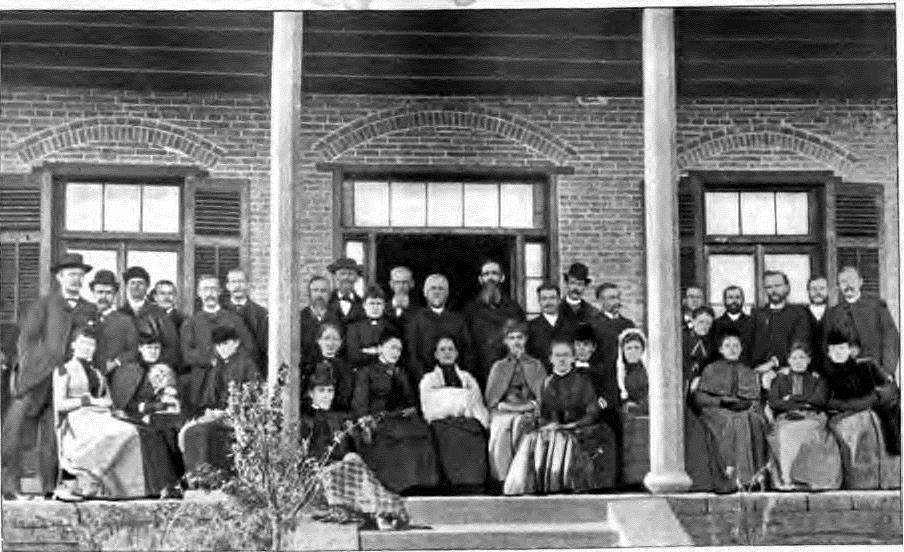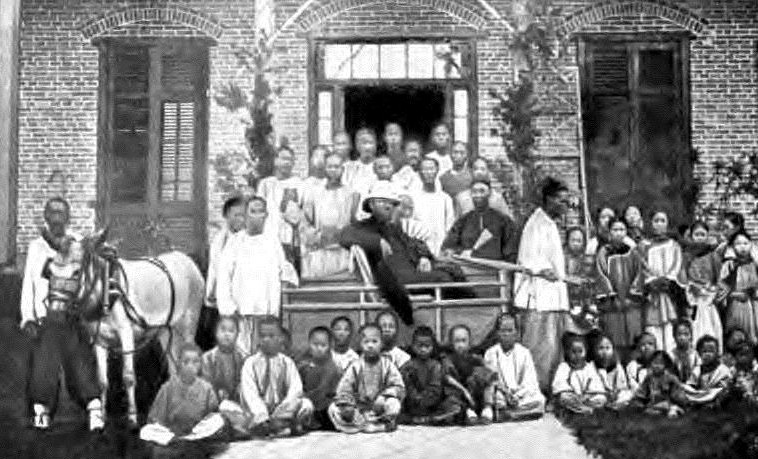The Rev. John L. Nevius: The Holy Spirit Gives a Lesson in Chinese

The Presbyterian Mission of Shantung, Dr. Nevius in the center.
But Nevius became determined to investigate the demonic, and he began to collect information on possessions, hauntings and exorcisms from local sources and from the classical Christian literature available to him.
It was my hope when I began to investigate the subject of so-called “demon possession” the Scriptures and modern science would furnish the means of showing to the Chinese, that these phenomenon need not be referred to as demons. The result has been quite the contrary.[5]
About 1871 Nevius encountered a landmark case. It referred to a twelve year old boy who had repeated bouts of severe possession. On many occasions the local medium had been employed and she would alleviate the symptoms for a while, only to have the possession state recur not long after. However, on one occasion a recently baptized convert was called into the case instead of the medium. The new Christian prayed over the possessed boy as he lay in an unconscious state:
Then turning to the prostrate boy he said in almost Scriptural words: “I command you in the name of Jesus Christ to come out of him!” The boy uttering a piercing cry, was at once restored to consciousness. I [Nevius] can say from personal knowledge that he never had another of those attacks from that day to this…
It may be well to state that no Protestant missionary, so far as I know, has ever given native converts instructions as to casting out spirits; and few, if any have dreamed that their converts would have the disposition, the ability, or the opportunity to do so. When converts have undertaken to do it, it has always been from an unsuggested spontaneous impulse, the natural result of reading the Scriptures and applying its teachings to their actual circumstances.[6]
This case converted his interest in the demonic into a permanent pursuit. He studied each incident he heard of first hand, with a through interview of all the persons involved, Christian and non-Christian. This was not easy, for he found that most Chinese were reluctant to talk to foreigners about these matters (his old language teacher was an exception). The Chinese converts had perceived that the missionaries did not like to hear of the demonic, nor would they believe them if told. Chinese rules of decorum dictated that such an issue not be pressed. Further, many Chinese felt that in relating the stories of exorcism one placed one’s family in jeopardy of demonic retaliation.[7] In spite of these obstacles, Nevius was able to amass interview data on a substantial number of possession cases, only a few of which appear in Demon Possession.

Dr. Nevius and the “Famine Boys” at the “Nan-Lou.”
In 1879 Nevius sent a circular letter to fellow missionaries requesting further information and opinions on possession. In today’s parlance, the letter would be called an open-ended questionnaire. He received a substantial response from all over China, including some from native Christians. These responses make up the heart of Demon Possession. From the answers, a clear pattern emerged that repeated Nevius’ experiences. The missionaries came to China believing that demon possession was a thing of the past, belonging to a former dispensation, but were forced to conclude that this was not true. Further, in every case reported it was a native Christian, not missionary, who first practiced exorcism, in much the same way and for the same reasons as related above. Consistently, the missionaries were taught by the converts to disregard cessationism and accept as continuously valid the Bible’s descriptions of the demonic and exorcism.[8]
Category: Church History, Spring 2014


